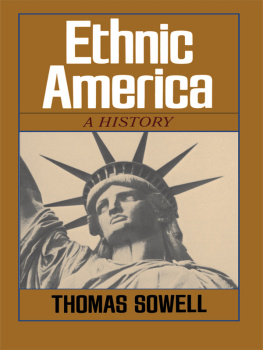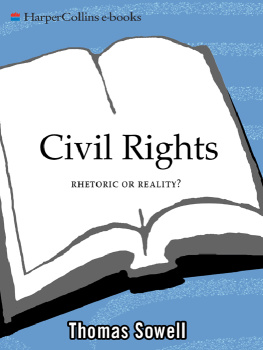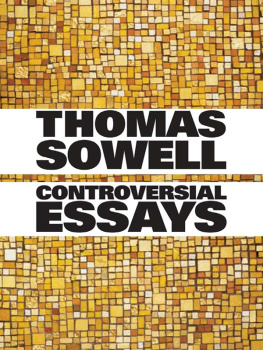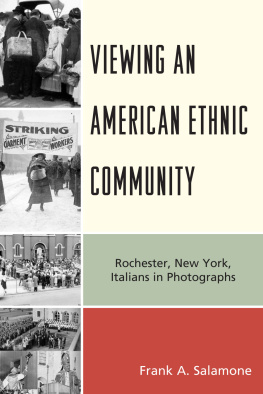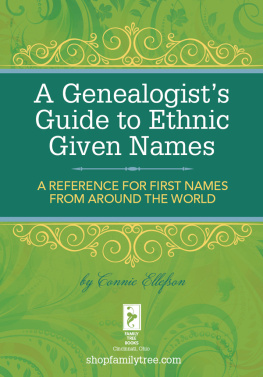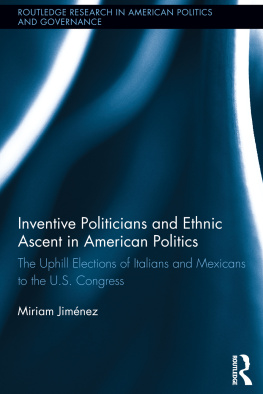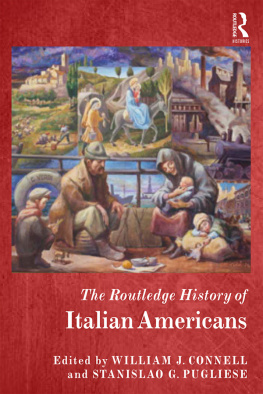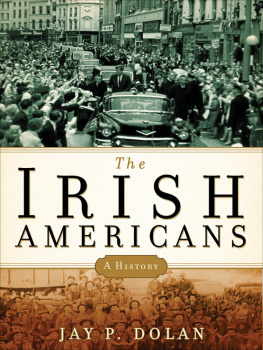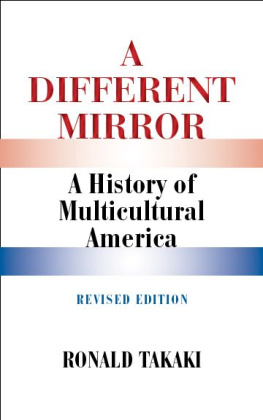Sowell - Ethnic America: a history
Here you can read online Sowell - Ethnic America: a history full text of the book (entire story) in english for free. Download pdf and epub, get meaning, cover and reviews about this ebook. City: New York, year: 1981;2011, publisher: Basic Books, genre: Politics. Description of the work, (preface) as well as reviews are available. Best literature library LitArk.com created for fans of good reading and offers a wide selection of genres:
Romance novel
Science fiction
Adventure
Detective
Science
History
Home and family
Prose
Art
Politics
Computer
Non-fiction
Religion
Business
Children
Humor
Choose a favorite category and find really read worthwhile books. Enjoy immersion in the world of imagination, feel the emotions of the characters or learn something new for yourself, make an fascinating discovery.
Ethnic America: a history: summary, description and annotation
We offer to read an annotation, description, summary or preface (depends on what the author of the book "Ethnic America: a history" wrote himself). If you haven't found the necessary information about the book — write in the comments, we will try to find it.
This classic work by the distinguished economist traces the history of nine American ethnic groupsthe Irish, Germans, Jews, Italians, Chinese, African-Americans, Puerto Ricans, and Mexicans.
Sowell: author's other books
Who wrote Ethnic America: a history? Find out the surname, the name of the author of the book and a list of all author's works by series.
Ethnic America: a history — read online for free the complete book (whole text) full work
Below is the text of the book, divided by pages. System saving the place of the last page read, allows you to conveniently read the book "Ethnic America: a history" online for free, without having to search again every time where you left off. Put a bookmark, and you can go to the page where you finished reading at any time.
Font size:
Interval:
Bookmark:



Library of Congress Cataloging in Publication Data
Sowell, Thomas, 1930
Ethnic America.
Includes bibliographical references and index.
1. MinoritiesUnited StatesHistory.
2. United StatesEthnic relations. I. Title.
E184.A1S688 973.04 8068957
ISBN 0-465-02074-7 (cloth) AACR2
ISBN-10: 0-465-02075-5 ISBN-13: 978-0-465-02075-1 (paper)
eBook ISBN: 9780786723157

Copyright 1981 by Basic Books, Inc.
Printed in the United States of America
Designed by Vincent Torre
To Birdie and Lacy, and the memory of Ruth
Introduction
THE AMERICAN MOSAIC
T HE PEOPLING of America is one of the great dramas in all of human history. Over the years, a massive stream of humanity45 million peoplecrossed every ocean and continent to reach the United States. They came speaking every language and representing every nationality, race, and religion. Today, there are more people of Irish ancestry in the United States than in Ireland, more Jews than in Israel, more blacks than in most African countries. There are more people of Polish ancestry in Detroit than in most of the leading cities in Poland, and more than twice as many people of Italian ancestry in New York as in Venice.
The sheer magnitude of American ethnic communities makes them autonomous cultures with lives of their ownneither copies of some mainstream model nor mere overseas branches of some other countrys culture. Chow mein, the St. Patricks Day parade, and the Afro hairdo all originated on American soil. Far from taking direction from overseas, American ethnic communities have supplied leadership to their countries of origin. The first president of Ireland, Eamon de Valera, was born in Brooklyn. Israeli Prime Minister Golda Meir was born in Milwaukee. Liberia was for more than a century ruled by the descendants of freed American Negro slaves.
The massive ethnic communities that make up the mosaic of American society cannot be adequately described as minorities. There is no majority. The largest single identifiable ethnic strain are people of British ancestrywho make up just 15 percent of the American population. They barely outnumber German Americans (13 percent) or blacks (11 percent). Millions of Americans cannot identify themselves at all ethnically, due to intermixtures over the generations.
The setting in which the history of all these peoples unfolded is no less impressive than the numbers and varieties of the peoples themselves. The United States is one of the largest cultural-linguistic units in the history of the world. From San Francisco to Boston is the same distance as from Madrid to Moscow. Yet here there is one language, one set of laws, and one economy in an area that, in Europe, is fragmented into a multitude of nations, languages, and competing military and political blocs. The size and cohesion of the American society are all the more remarkable because of the diverse origins of the people who make it up. As a unified nation, the United States is older than Germany or Italy. As for size, Texas is larger than France, Colorado is larger than Great Britain, and Italy is only two-thirds the size of California. The United States as a whole is larger than the Roman Empire at its greatest expansion.
The mixture of unity and diversity runs through American history as through American society today. No ethnic group has been wholly unique, and yet no two are completely alike. Each group has its own geographic distribution pattern, reflecting conditions when they arrived on American soil and the evolution of the industries and regions to which they became attached. Even the ages of American ethnic groups vary widely. Mexican Americans and Puerto Ricans have median ages of less than twenty years, while the average Irish American or Italian American is more than thirty years old, and Jewish Americans are over forty. These age differences reflect not only current fertility patternssome groups are composed disproportionately of childrenbut also historic changes in fertility patterns that have caused the successive generations to be of drastically altered size in some groups.
Incomes, occupations, and unemployment rates differ substantially among American ethnic groups, as do rates of crime, fertility, and business ownership. The explanation of those differences is complex and in many ways surprising. None of the easy explanations fits all the facts. Color has obviously played a major role in determining the fate of many Americans, and yet a black ethnic group like the West Indians earns more than a predominantly white ethnic group like the Puerto Ricans, and the Japanese earn more than whites in general. The initial wealth of a group and its time of arrival are obviously important, as many wealthy old families show, but the Jews arrived late and penniless in the nineteenth century and are now more affluent than any other ethnic group.
The incomes, occupations, and unemployment rates of American ethnic groups are too different from one another to be described by any generalization. Moreover, it is as misleading in the economic area as in other areas to think of them as minorities who fall below some majority, or national average, in socioeconomic terms. A number of ethnic groups exceed the national average in socioeconomic status.
Family Income Index (U.S. Average = 100)
| Jewish | |
| Japanese | |
| Polish | |
| Chinese | |
| Italian | |
| German | |
| Anglo-Saxoo | |
| Irish | |
| TOTAL U.S. | |
| Filipino | |
| West Indian | |
| Mexican | |
| Puerto Rican | |
| Black | |
| Indian |
S OURCE: U.S. Bureau of the Census and National Jewish Population Survey.
Many factors are responsible for these economic differences among the various groups. Age is a major factor that is often overlooked. Ethnic groups that differ in average ageby ten or twenty years in some caseshave vastly different percentages of their population in the older age brackets, where people in professional and other high-income occupations are concentrated. For example, about 20 percent of American Indians are age forty-five or older, while twice that percentage of Polish Americans are that old. Higher income occupations typically require either long periods of education or long years of experience, or both, so it is not surprising that older ethnic groups earn more than younger ethnic groups. What is misleading is when these gross differences are regarded as showing either the extent of employer discrimination or of ethnic ability. Comparisons of the earnings of thirty-year-old males show a narrower spread among ethnic groups, and when the comparison is between thirty-year-old males with the same education, the differences become even smaller.
Font size:
Interval:
Bookmark:
Similar books «Ethnic America: a history»
Look at similar books to Ethnic America: a history. We have selected literature similar in name and meaning in the hope of providing readers with more options to find new, interesting, not yet read works.
Discussion, reviews of the book Ethnic America: a history and just readers' own opinions. Leave your comments, write what you think about the work, its meaning or the main characters. Specify what exactly you liked and what you didn't like, and why you think so.

